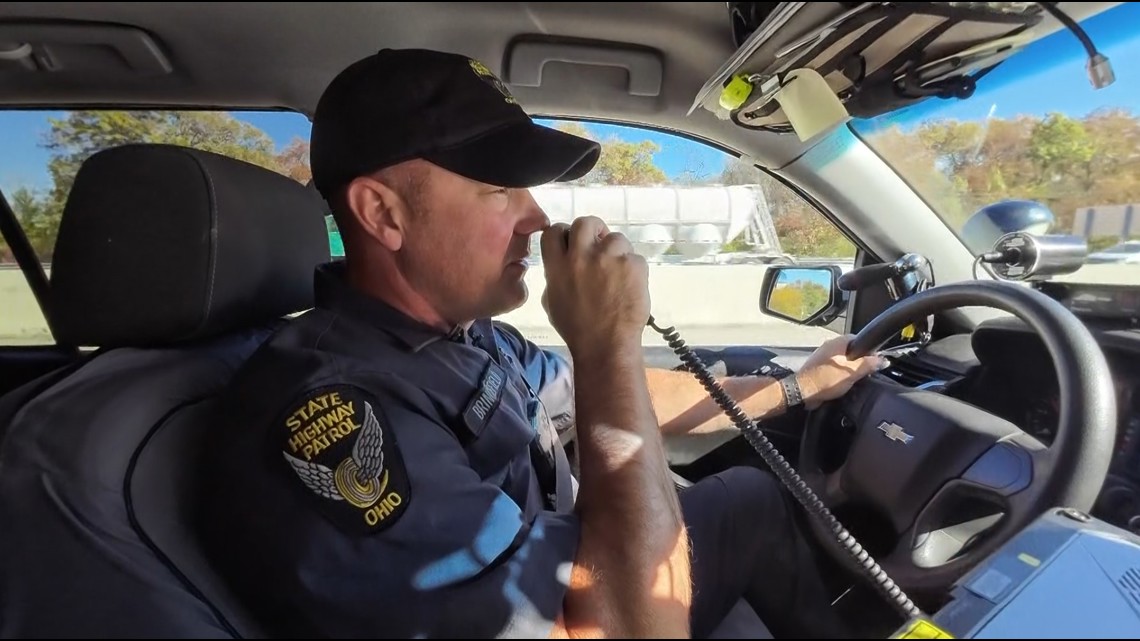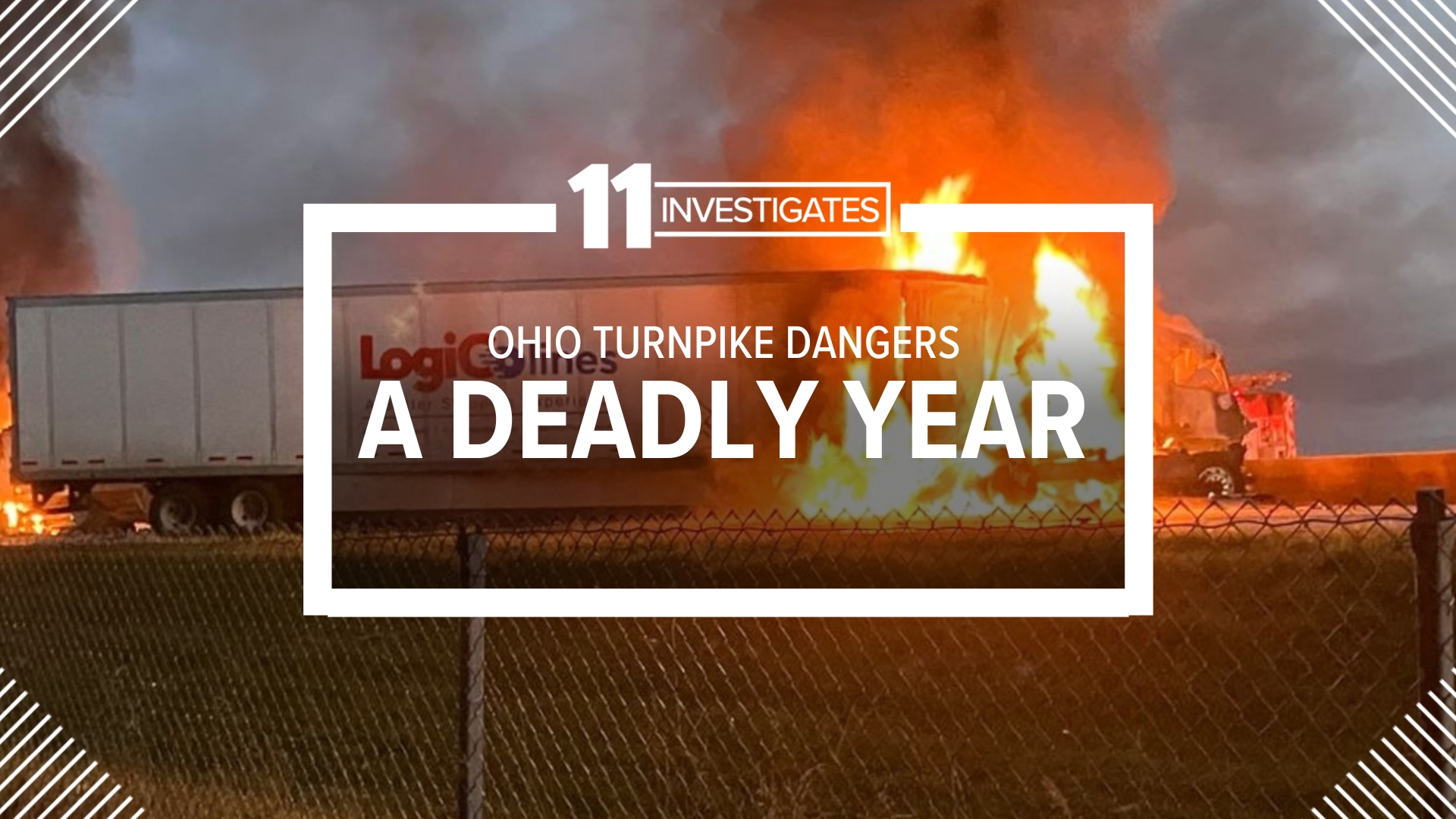Ohio Turnpike dangers: A deadly year | 11 Investigates
An 11 Investigates' analysis finds distracted driving, speeding, volume, serious accidents and deaths take a large jump on one of Ohio's most popular roadways.

Sitting in the median, near Exit 64 on the Ohio Turnpike, Sgt. Adam Brincefield scans the horizon.
As the commercial enforcement coordinator for the Ohio State Highway Patrol’s District 1, many of Brincefield’s days are spent looking for violations on commercial vehicles.
OSHP is a data-driven force, and the numbers support what regular travelers are seeing – commercial volume is up significantly on the turnpike.
Increased traffic isn’t necessarily a concern, though multiple national studies in the past decade have documented that higher traffic volumes lead to more crashes. But when those crashes involve vehicles weighing more than 25,000 pounds, the risk of serious injuries increases significantly.
“We’re seeing operators or companies try to keep costs down as best they can,” Brincefield said. “That being said, sometimes they take shortcuts in maintaining the vehicle.”
Another trooper radioed him that he just clocked a semi truck going 77 mph in a 70 mph zone, and it was headed his way.

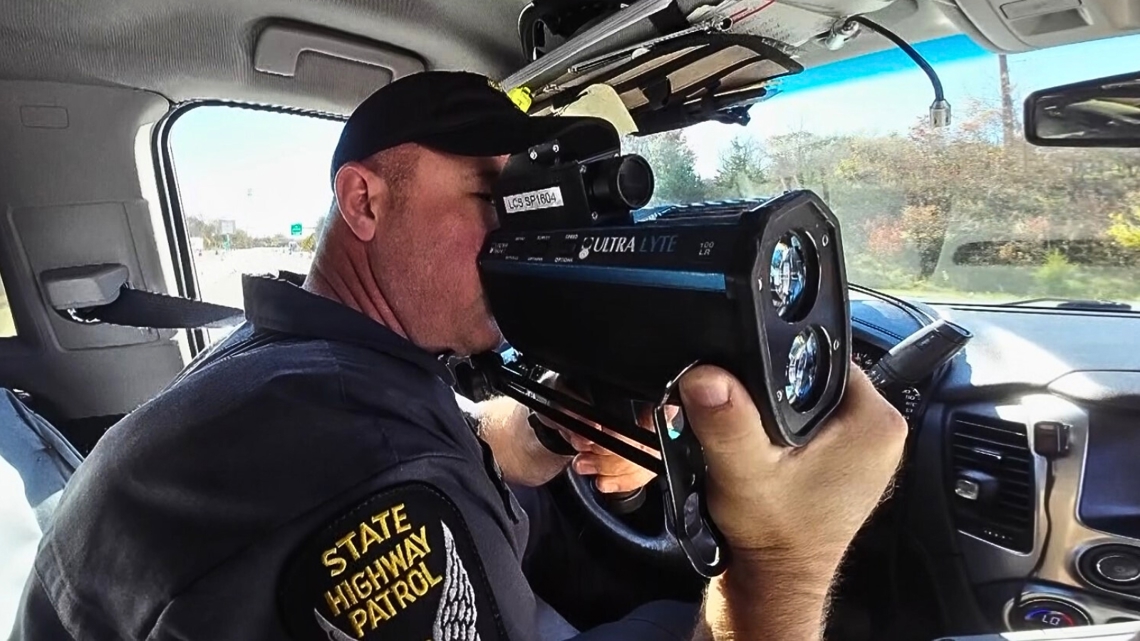
Increasing volume and speed are just two of the concerning trends being played out on the 241-mile turnpike.
11 Investigates spent months digging into reports and data to paint a clearer picture as to why 2024 has been an unusually violent year on the roadway. Our efforts included riding with Brincefield and interviewing other OSHP troopers – the guardians of the east-west thoroughfare between Indiana and Pennsylvania.
The Warminster, Pa.-based rig blew past Brincefield, who pulled onto the roadway and rapidly accelerated until he caught up to the vehicle. He called in the plate to dispatch and waited for any relevant findings.
He commented on the outward appearance of the rig as he coasted just off the left bumper of the vehicle. Nothing jumped out.
“It doesn’t look like it’s overweight. Often the tires would flatten out if it’s too heavy. I’m not seeing that,” Brincefield said.
But he wanted a closer look and pulled the vehicle off the roadway. Exiting his vehicle, he noted the registration sticker was valid through May 24. It had been expired for nearly six months.
He lead the truck to a plaza a couple miles down the road so he could safely do a walk-around. That inspection revealed issues with multiple tires. The two located near the axle on the driver’s side had almost no tread – a federal violation and a potentially serious safety issue.

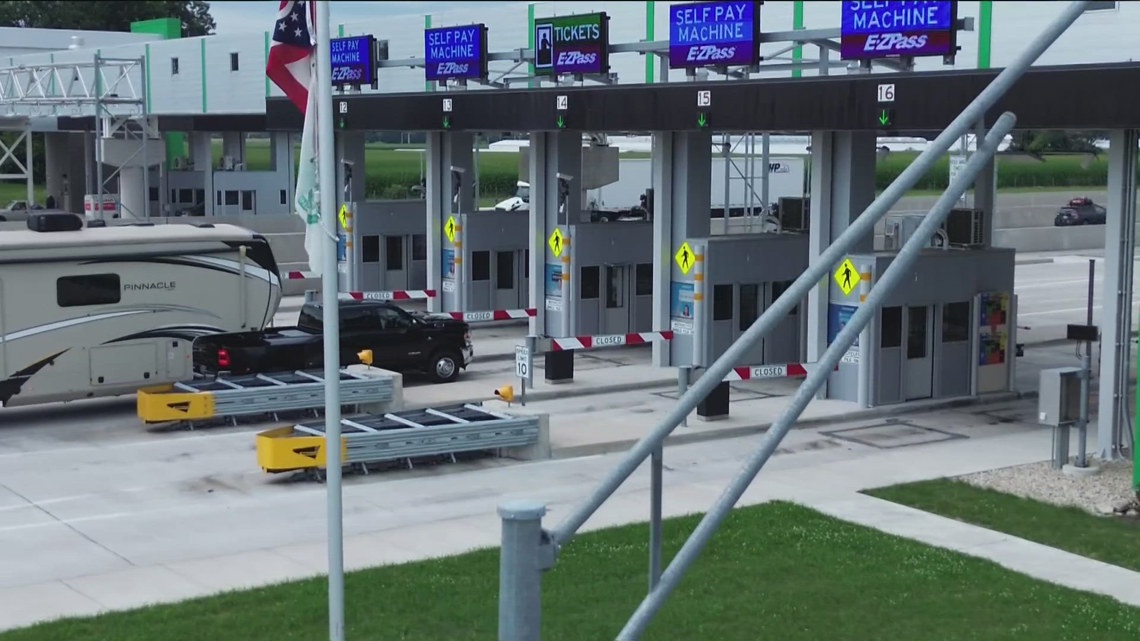
Brincefield took the vehicle out of service, meaning the driver couldn't return to the road until the tires were replaced.
The driver was cooperative, explaining that the company was going through bankruptcy and the owners had been spending little on maintenance.
As Brincefield mentioned minutes earlier, it was a company taking a shortcut – a shortcut that puts fellow turnpike drivers at risk.
A deadly year
When 78-year-old Rita Robinson entered the turnpike at Milepost 142 in Lorain Township on Sept. 26, she headed the wrong direction – westbound in the eastbound lanes. She died when she collided head-on with a semi.
Robinson became the 17th person to be killed on the turnpike in 2024, making it the deadliest year since 1994.
The deadliest day this year was on Aug. 15, when four people died in a series of early morning crashes.
The lead accident occurred at 5:50 a.m. and resulted when a driver from Minnesota said she was confused by a new toll plaza at Milepost 49 in Swanton Township. When she quickly decelerated in the right eastbound lane, a semi ran into her causing both vehicles to careen out of control.
Her son and husband were killed as a result.


Weeks earlier, 11 Investigates released multiple stories on the new toll plaza. Hundreds of people reached out to the team, saying how it was confusing or having witnessed drivers behaving erratically as they tried to avoid missing the toll.
So many drivers have missed the toll, that the turnpike was forced to hire additional customer service representatives to handle calls from angry customers who received invoices in the mail.
After traffic backed up following that initial morning crash, about 30 minutes later a semi ran into the vehicles among the stopped traffic. The cab exploded into flames, killing the driver.
A short time later, another semi crashed into traffic stopped in the westbound lanes. This time, a woman from New York died when the semi struck an SUV – in which she was sleeping in the back.
11 Investigates reviewed the reports for the 16 fatal accidents (the initial Aug. 15 accident is the only one that resulted in two deaths.)
In two incidents, pedestrians were struck after they went into the roadway. Two motorcyclists died – one after the bike’s tire blew out, the other after the driver hit a hole and lost control.
In the majority of crashes, the contributing vehicle or semi was at least 10 years old, meaning there were likely limited safety features that are often found in today’s new vehicles.
In 10 of the 16 accidents, a semi was involved.
In some cases, the semi was hit but on Aug. 4, a semi’s tire exploded causing it to lose control and crash through a construction berm and into another semi. It was a scenario that Brincefield possibly prevented from being repeated when he pulled over the Pennsylvania rig.


The Ohio Turnpike is one of the state’s safest routes. It is far behind I-75 and I-71 when it comes to accidents and fatalities.
Regular drivers will tell you that if you have to be driving after a snowstorm, the turnpike is one of the best places to be because snow and ice are removed so quickly.
But multiple data sets point to an increasingly more dangerous roadway, at least in 2024.
Lamar Stewart travels the turnpike once a week. As a regular driver, he says it’s a scarier place.
“I just stay in the left lane because the volume is so high on the turnpike," Stewart said. "I noticed it in the last two years."
And he’s right. But volume isn’t the only concerning trend.
By the numbers
The series of accidents on Aug. 15 was the genesis of this investigation.
OSHP keeps meticulous records of incidents on the roadways. If numbers indicate a stretch of road is seeing a rise in incidents, it shifts resources in an attempt to bring those numbers down. Much of our data was provided by OSHP.
“We are data driven and intentional with our actions so that we can be as impactful as possible,” said Lt. Ray Santiago of the OSHP’s Public Affairs unit.
In 2024, there has been an increased focus on the turnpike. That focus has revealed increasingly bad behavior from drivers.
Through September, OSHP made 20,949 enforcement stops on the turnpike – a jump of 27% from the same point in 2023. Speeding citations increased by 25%, seat belt violations by 90%, distracted driving by 146%. Overall volume has climbed by 9.9%.

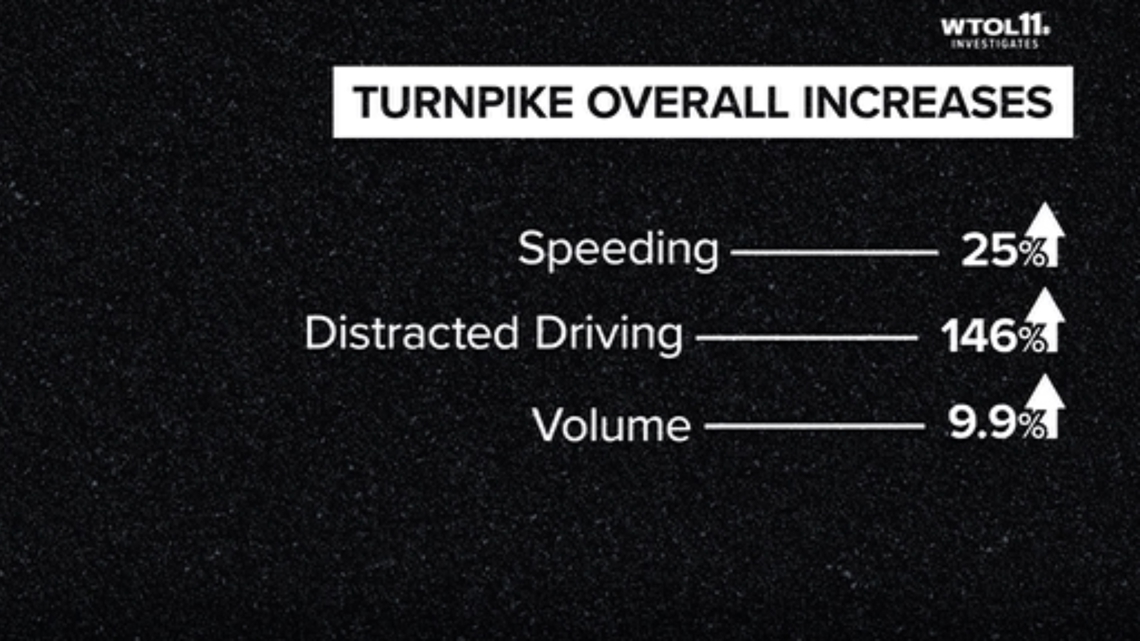
Clockings of drivers traveling more than 100 miles per hour aren’t rare occurrences. Last month, OSHP chased a stolen car suspect who was traveling more than 105 mph.
“Coming out of the pandemic, we kind of saw that it wasn’t just speeding, it was like the extreme speeds,” Lt. Santiago said. “We knew anecdotally some of those folks that we were interacting with and pulling over, they didn’t even realize they were doing it. The roads were wide open back then. Unfortunately, those behaviors kind of continued.”
Distracted driving became a primary offense in Ohio in April 2023. Across the state, troopers have been encouraged by a decrease in crashes related to distracted driving, but it's also understood that the number is likely underreported as far as a driver in a crash being distracted.
"No one's ever going to be involved in a crash and just throw their hands up in the air and say, 'go ahead and enhance that violation because I was distracted,'" Lt. Santiago said. "Unfortunately, when we are making those enforcements, it takes a minute to get those folks stopped. Why? Because they don't even see us because they're not paying attention."

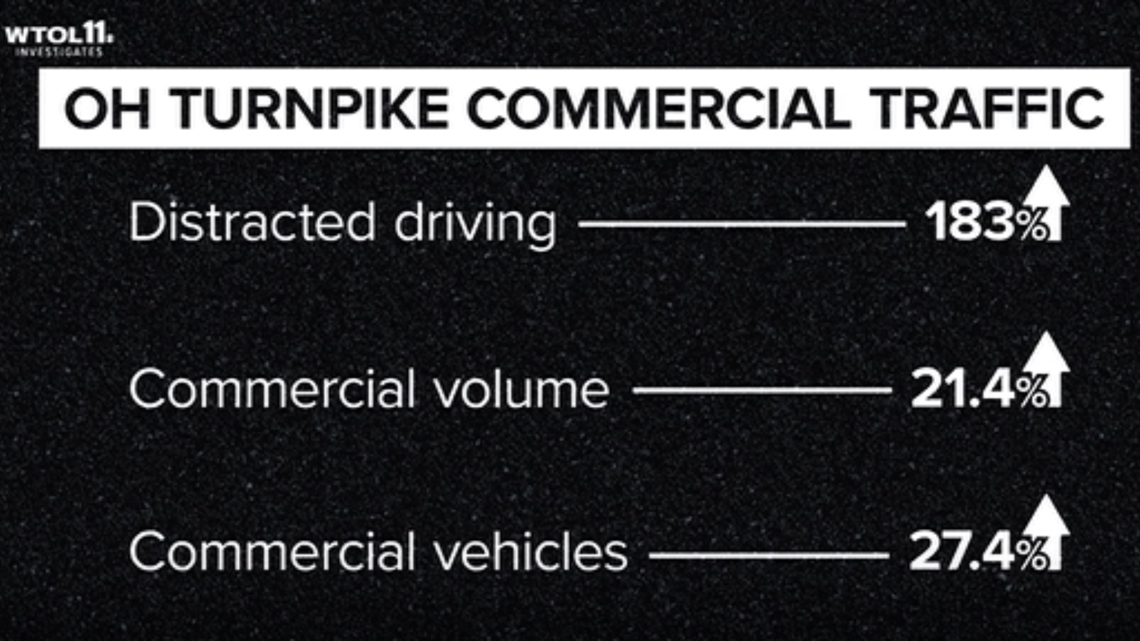
When it comes to commercial traffic, there have been other issues. Enforcement stops have increased 18%, distracted driving 183%, and volume is up 21.4%. Commercial vehicles now make up 27.4% of all turnpike traffic.
In reviewing six years of records, total volume and semi volume have never been higher.
Through September, 11,515,879 commercial vehicle trips were registered. In 2019, at the same point of the year, there were 8,934,226 trips.
By comparison, the Pennsylvania Turnpike has seen modest to no gains from 2023. Overall volume has increased 1.4% but commercial traffic has seen no increase at all in Pennsylvania.
Tom Balzer, president of the Ohio Trucking Association, said the Ohio Turnpike is a pivotal route as the U.S. economy continues to rebound from the pandemic.
“As the economy continues to grow, you’re going to see an increase in the volume of freight,” he said.
But the amount of traffic being driven onto the turnpike is growing because of an evolving industry.
“We used to go to stores and pick things up and then the truck would just deliver a large truckload of product to a store.”
But now, those trucks are taking their loads to distribution centers, like Amazon. From there, delivery trucks bring the packages right to a doorstep.
“As you see this shift to more distribution centers, more miles are going to be on more major artery roads like the turnpike to be able to get distribution centers, which are positioned very closely to these arteries,” Balzer said.
Whether it’s from volume or reckless driver behavior, the numbers point to a more dangerous turnpike.
Accidents are up 1.1% and serious accidents 36.4%, resulting in a 7.5% increase in injuries and a spike of 89% in deaths.


Besides increasing its presence on the turnpike, OSHP has dramatically increased the number of commercial vehicle inspections this year. That number has climbed by 124% to more than 2,100 through the end of October.
When a commercial vehicle is pulled over for an inspection, a trooper can do a walk-around of the truck – measuring tread on tires, looking for any type of structural defect and reviewing driver logs.
Brincefield showed the 11 Investigates team a book containing federal regulations that was several inches thick.
Company safety records are documented in the online Safety and Fitness Electronic Records System. For example, M & J Superior LLC of Dallas, Texas, owned the vehicle involved in the Aug. 4 accident, in which a tire blew out.
Punch that company name into the SAFER database and it shows that 35.7% of the companies vehicles have been taken out of service after inspection within the past 24 months. That is well above the national average of 22.3%. Numbers like that are a red flag for commercial inspectors.
When told of our investigation into turnpike safety, the Ohio Turnpike and Infrastructure Commission provided the following statement:
“The Ohio Turnpike and the Ohio State Highway Patrol work together year-around to keep motorists and everyone who works on the toll road safe by promoting safe driving habits to prevent vehicle crashes. These efforts include public information campaigns, such as press events at the Toledo and Cleveland auto shows, six customer appreciation events held at various service plazas during the busiest travel holidays of the year from Memorial Day to Thanksgiving, and numerous traditional and social media outreach campaigns promoting roadway safety, such as reminding motorists to slow down when driving through construction work zones.
“In addition, the Ohio Turnpike and toll road agencies everywhere are participating in Be Safe Together — a global campaign urging motorists to be self-aware of unsafe driving behaviors behind the wheel, such as speeding, distracted and impaired driving, and not wearing a seatbelt.
“Roadway safety can be greatly improved with seatbelt use. This year, there have been several unfortunate crashes where one or more of the vehicle occupants were not using a seatbelt.
“Improving roadway safety is a shared responsibility, whether it’s on two wheels, four wheels or 18 wheels, and together through traffic safety enforcement, education, and making good choices behind the wheel, we can make the Ohio Turnpike and roadways everywhere safer for all motorists and roadway workers.”
Focus on Safety
Just like many industries, the trucking industry has had an increasingly difficult time recruiting quality workers since the pandemic. Part of that is because of prequalifying drug screens.
Marijuana is illegal at a federal level. Applicants have issues with passing the tests, particularly since marijuana can stay in your system for more than a month.
Balzer said the requirements to become a driver are much more stringent than 10 years ago, including time at a driving school (Ohio has more than 50) and additional training with in-house trainers at a company hiring the applicant.


“Very rarely do we see a scenario anymore where you would go out and get in a truck and teach yourself to drive or a scenario where your uncles or your parents have a truck and teach you to drive,” Balzer said.
And the industry is using advanced technology to ensure the drivers should be behind the wheel.
“We can now use artificial intelligence in some of the newer vehicles to tell if the driver’s eyes are not on the road. It will highlight for us and alert the safety department if a driver has violations or times that their eyes are not on the road. It will mark those on the camera so that we can see those and be able to review those with the driver,” Balzer said.
Under federal regulations, a driver can be fined nearly $3,000 and the company $10,000 if the driver is cited for texting and driving.
Balzer pointed out that the American Trucking Association’s driver of the year is from Ohio. Dave Wolford has driven for more than 20 years and more than 2.5 million accident-free miles.
“He and all of our professional drivers will tell you that their one responsibility is to make sure that not only that they get home safely to their family at the end of the workday, but everyone else around them gets home safely,” Balzer said. “Nobody wants that accident on their record. Nobody wants that accident on their conscience.”
Increased enforcement and focus
One day after 11 Investigates’ ride-along with Sergeant Brincefield, Lt. Santiago pointed to the experience as something troopers are seeing every day.
“We’re sending units out there to conduct those commercial vehicle inspections, and it’s good to get that perspective,” Lt. Santiago said. “We may not have understood what the safety concerns were that could have been deadly in an instant until we performed that inspection. There are multiple things that if just one thing fails, it could result in tragedy.”
The bald tires on the vehicle that Brincefield stopped were in an area that would have made it difficult for a driver to maintain control if one or both of the tires had exploded. Their condition also could affect traction and the ability to stop.


One of the reasons for the jump in enforcements is because OSHP has noticed an increasing number of big rigs on the road.
“I think it points out the importance of being fully aware of your surroundings and not being distracted when you’re driving and following speed limits and maintaining assured clear distance. We need to be responsible when sharing the road, particularly in areas where we see an increase in commercial vehicle traffic.”
Lt. Santiago pointed out that semis have larger blind spots than cars or SUVs. In addition, drivers of smaller vehicles might drive more nervously around them.
An analysis of turnpike financial reports makes one thing very clear: there will not be an attempt to limit the volume of truck traffic.
The turnpike collected $294 million in toll revenue through September and $183 million of that is from commercial vehicles.
Last year through September, the numbers were $273 million and $173 million.
Lt. Santiago said that even though volume and enforcement numbers are up, drivers should be reassured by knowing that OSHP is out on the roads.
“Every one of these interactions has a number attached - a name attached to them - whether it’s the person getting the citation, and hopefully we’re changing their behavior and we’re educating them and they become more aware,” he said.
“But more importantly, every one of those fatal crashes and fatalities, there’s a family impacted. There are first responders who had to respond to those scenes and handle them. No one that’s involved is ever going to be the same. Until we get that number to zero, we know we have work to do.”

